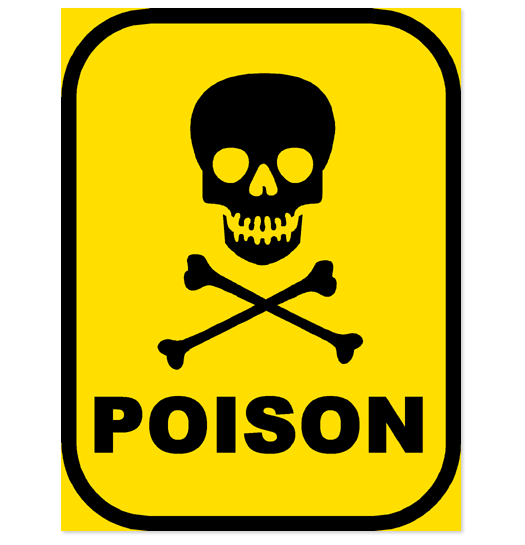 Since almost the first day FRANK opened, nearly 3 years ago, we have wanted to do a theme centered around poisonous foods. Why? Because SO MANY of the foods we eat are poisonous! Either if prepared or harvested improperly, or if eaten in too great a quantity. Some poisonous foods we appreciate SPECIFICALLY for their poisonous qualities. (Why do you love the nasal attack of horseradish, or the intense burn of habanero peppers? Both are poisons designed to repel predators, yet we love them because of the pain they inflict upon us.)
Since almost the first day FRANK opened, nearly 3 years ago, we have wanted to do a theme centered around poisonous foods. Why? Because SO MANY of the foods we eat are poisonous! Either if prepared or harvested improperly, or if eaten in too great a quantity. Some poisonous foods we appreciate SPECIFICALLY for their poisonous qualities. (Why do you love the nasal attack of horseradish, or the intense burn of habanero peppers? Both are poisons designed to repel predators, yet we love them because of the pain they inflict upon us.)
I am loath to give up Halloween for any reason. It’s my favorite holiday, and I usually spend it scaring the crap out of kids in my neighorhood…a much-loved pastime. But this year when Jennie proposed we do FRANK on Halloween and finally do that Poison menu we’ve been tossing around, I figured it was time.
We had been keeping a list of poisonous foods we’d like to incorporate on the menu for a long time, and the list was far too long to use all of them. But we settled on the following. All these ingredients are either poisonous themselves, or come from plants or animals that have poisonous parts:
absinthe (wormwood)
alcohol
almonds
ants
bell pepper
chive
cocoa/chocolate
coffee
eggplant
elderflower
frog
green potato
garlic
hot chiles
leek
mustard greens
nutmeg
rhubarb
tomato leaf
wild mushrooms
Our friend Stephanie Casey, who has a cool blog called Real Fine Food, came to FRANK on Halloween night to photograph the meal live and blitz it to our Facebook page, so most of the images you’ll see on this page were taken by her. We’re so busy cooking and plating and serving and educating our guests that we scarcely have time to take photos, so thanks, Stephanie, for helping out!
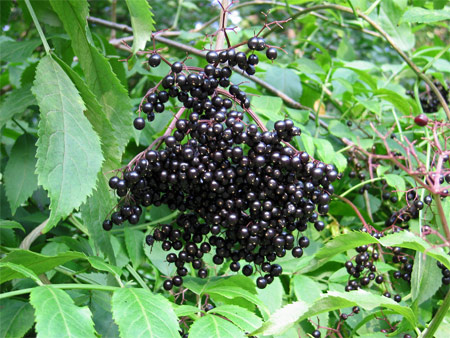 We welcomed our guests with a champagne cocktail…champagne, of course, containing alcohol, which everyone knows is poisonous. However, we added a little extra something into the champagne to make it EXTRA toxic! Elderflower liqueur. Elderflowers come from the elderberry plant, which is a big shrubby bush famous for both its flowers and its fruit. Every part of the elderberry plant contains toxic levels of cyanide EXCEPT for the flowers. Once the flowers have turned into berries, the berries themselves are poisonous…however, cyanide breaks down in the presence of heat, or through the process of fermentation. Which is why you can safely drink elderberry wine or jam. The flowers, however, are pristine and safe and are often made into popular beverages in Europe and other parts of the world. Incidentally, elderberry has been shown in several lab tests to be highly effective against several virulent strains of influenza! I’m not sure if our cocktail would cure the flu, but it was ghoulishly delicious!
We welcomed our guests with a champagne cocktail…champagne, of course, containing alcohol, which everyone knows is poisonous. However, we added a little extra something into the champagne to make it EXTRA toxic! Elderflower liqueur. Elderflowers come from the elderberry plant, which is a big shrubby bush famous for both its flowers and its fruit. Every part of the elderberry plant contains toxic levels of cyanide EXCEPT for the flowers. Once the flowers have turned into berries, the berries themselves are poisonous…however, cyanide breaks down in the presence of heat, or through the process of fermentation. Which is why you can safely drink elderberry wine or jam. The flowers, however, are pristine and safe and are often made into popular beverages in Europe and other parts of the world. Incidentally, elderberry has been shown in several lab tests to be highly effective against several virulent strains of influenza! I’m not sure if our cocktail would cure the flu, but it was ghoulishly delicious!
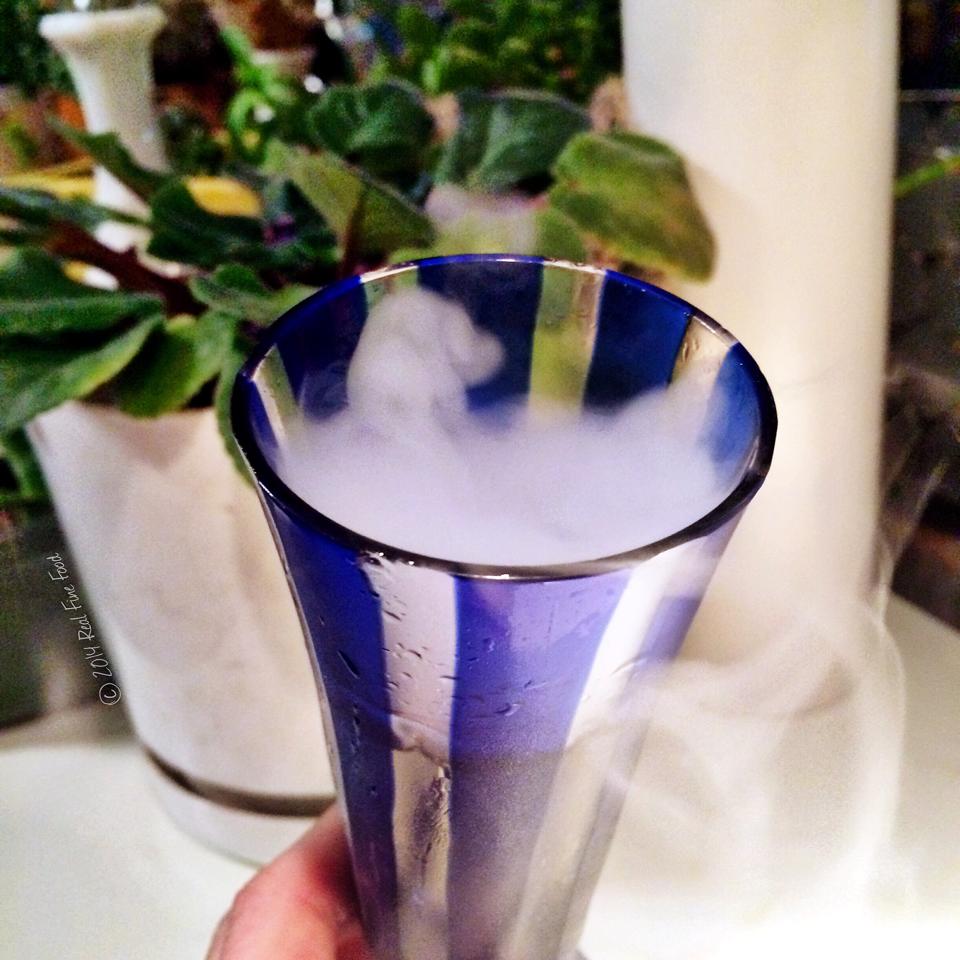
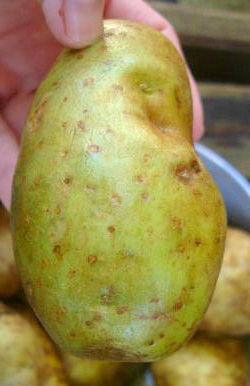
Next up was the welcome bite, or amuse bouche, which was a housemade green potato chip with black garlic, creme fraiche, and microbasil. Potatoes are a member of the nightshade family, just like tomatoes, eggplant, peppers, etc. Virtually ALL nightshades are poisonous, but the edible nightshades only have poisonous leaves, stems, and roots. They produce a toxin called solanine that is intended to keep predators from eating the growing parts of the plant, instead offering their tempting, poison-free fruit so that its seeds will be carried away to perpetuate itself. This is why you can’t safely eat raw tomato or potato leaves…but the fruit is just fine. Potatoes aren’t technically fruit, they’re a tuber and live below the ground with the roots. So they are safe to eat. However…if a potato gets unearthed and lays on top of the soil, exposed to sunlight, it begins an internal process to change itself into a full-blown potato vine. Two things happen immediately: it begins to produce chlorophyll beneath its skin (that green substance that gives leaves their color), and it begins to produce solanine (that poison that will prevent a passing animal from eating it, so it can fulfill its job of perpetuating life). Ever seen a green-skinned potato in the grocery store, or pulled a green chip out of a bag? This is a poisonous potato! Luckily, solanine breaks down in the presence of heat, just like cyanide does, so green potatoes can be made safe by cooking. (Though the solanine, if it has built up to a high level, can result in a bitter taste, even after cooking.) We intentionally exposed our potatoes to sunlight for a week to develop the color, then we fried them to make them safe to eat.
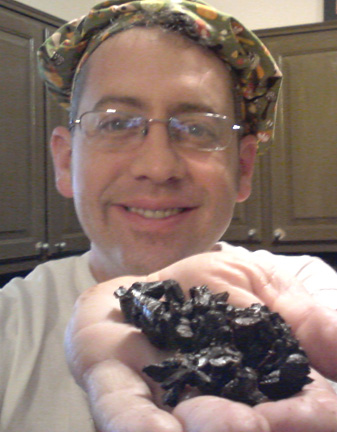
We topped the chips with black garlic, which is just ordinary garlic that has been fermented for a month or longer at high temperatures (above 90F), so that all the complex sugars in the garlic break down into potently flavorful compounds that also turn the garlic clove jet black. Black garlic is like nothing you’ve EVER tasted before. Pungent, incredibly sweet, dark, and so complex your brain will go crazy trying to decipher it. Like garlic, it is poisonous in massive quantities, but we’ll discuss that when we get to the soup course! These little bites were very popular, some folks came around begging for a second…or third!

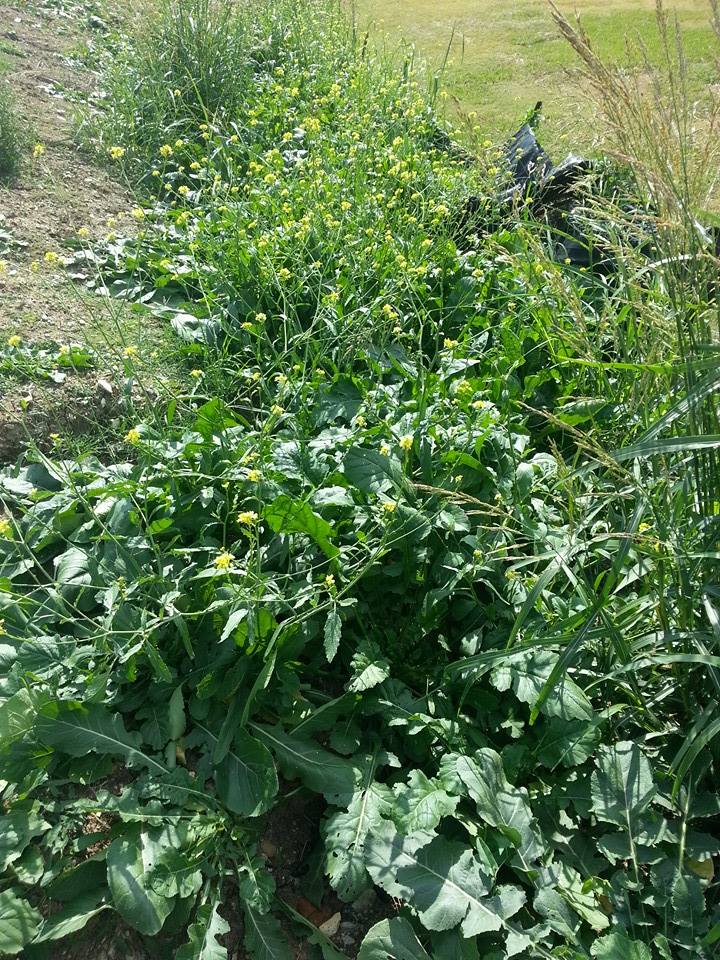
For our salad course, we started with a base of baby and wild greens. The baby greens were grown by our friend Tom Spicer of Spiceman’s FM 1410, who purveys incredible greens, herbs, and wild ingredients like foraged mushrooms. He sells to the public, and if you’ve never been by his place near Lower Greenville, you’ve missed out on a Dallas institution. The wild greens we foraged near my house in Lewisville…I stumbled across a prolific patch of wild mustard growing in an empty lot next to a subdivision, and I foraged the leaves and flowers. Mustard contains a compound called erucic acid, which is the irritant that makes the back of your nose burn when you eat mustard greens or prepared mustard. (Same compound in horseradish and wasabi.) This acid is also used to make chemical-grade weapons and mustard gas! So it’s definitely poisonous. However, like many toxic foods, we enjoy them specifically for their poisonous qualities. Mustard is one of the most common weeds around North America…it grows wild everywhere, it’s delicious, and it’s incredibly good for you. In moderation, of course! Most people cook mustard greens, but I also love them raw, and they really jazz up a salad.

The dressing for the salad was a rhubarb and tangerine vinaigrette. Most folks know that rhubarb is poisonous. The plant contains a toxin called oxalic acid, that has a very tart flavor (like all acids!) and can be deadly in enough quantity. Oxalic acid is concentrated in the leaves of the rhubarb plant, which means the stem is safe to eat either raw or cooked, but you must always trim away and discard the leaves. (You’d have to eat 20-30 pounds of leaves in a sitting to kill yourself, which isn’t likely.) Rhubarb stems are still high in other acids, which explains why they are so tart, and they make a fabulous dressing.
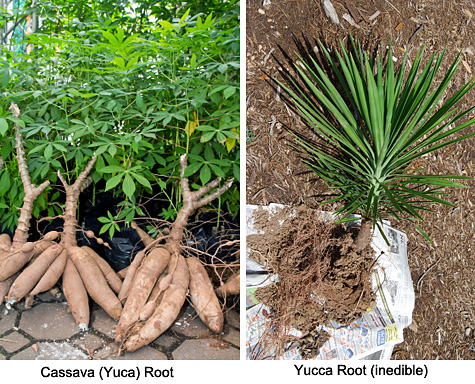 The greens were topped with a crumble of cassava, which is a root that is commonly eaten all around the world. It goes by many names, some of which you’ll be familiar with: manioc, yuca, tapioca, casabe… And it’s deadly poisonous. At least before being treated to remove the lethal levels of cyanide that exist in the root. Many cattle are killed each year by eating unearthed cassava roots. But, as we’ve mentioned, cyanide breaks down when you heat it or ferment it, or even dehydrate it. So cassava root can be made safely edible by a number of means, and it is an incredibly important source of nutrients for many people in the developing world. As a side note, in the US it’s very common to eat at Latin or Central American restaurants and see “Yucca” on the menu. This is a misspelling that has led many Americans to think that the spiny desert plant that is very common as an ornamental in this country, called Yucca, to be the source of the delicious, fluffy root that makes such incredible fries. Not so! The root of the yucca plant is too fibrous to eat. Those menus are misspelled, you’re actually eating Yuca, or Cassava, which you can see in this photo looks nothing like spiny yucca plants!
The greens were topped with a crumble of cassava, which is a root that is commonly eaten all around the world. It goes by many names, some of which you’ll be familiar with: manioc, yuca, tapioca, casabe… And it’s deadly poisonous. At least before being treated to remove the lethal levels of cyanide that exist in the root. Many cattle are killed each year by eating unearthed cassava roots. But, as we’ve mentioned, cyanide breaks down when you heat it or ferment it, or even dehydrate it. So cassava root can be made safely edible by a number of means, and it is an incredibly important source of nutrients for many people in the developing world. As a side note, in the US it’s very common to eat at Latin or Central American restaurants and see “Yucca” on the menu. This is a misspelling that has led many Americans to think that the spiny desert plant that is very common as an ornamental in this country, called Yucca, to be the source of the delicious, fluffy root that makes such incredible fries. Not so! The root of the yucca plant is too fibrous to eat. Those menus are misspelled, you’re actually eating Yuca, or Cassava, which you can see in this photo looks nothing like spiny yucca plants!

Beneath the salad was a bed of pickled eggplant. Eggplants are in the nightshade family but the fruit is safe to eat. In the old days, though, eggplant was very bitter and had to be salted to extract the liquids from its spongy fruit, which contained solanine. Modern eggplants have been selectively bred to reduce the amount of solanine in the fruit, so we can safely eat eggplant raw…though I’m not sure why you’d want to! Pickled eggplant is very popular in Italy, but is almost unheard of here. Chef Adrien decided to prepare it this way to surprise our guests, and even those who typically hate eggplant devoured it pickled! While most grocery stores carry only one, maybe two, types of eggplant, there are many dozens of varieties, some of which are red, white, even striped and speckled.
The star of the plate, though…was a frog leg. Frogs and toads are poisonous creatures. Ever seen your dog try to eat a toad, and then spit it back out and stick his tongue in the air repeatedly? Virtually all frogs and toads have glands in their skin that produce toxic alkaloids to protect themselves from predators. Some species are deadly to humans even in very small amounts. The golden dart frog of Colombia is one of the most deadly creatures on the planet! Luckily, the poison remains entirely in the skin, and the meat beneath is delectable. Lots of our diners had never eaten frog and were very nervous about it, but I encouraged everyone to taste just a bite. And not a single frog leg came back uneaten out of 7 dinners! Frog is DELICIOUS, especially the way Chef Adrien prepared it…brined in a heavily spiced buttermilk for 4 hours, then pan seared to crisp, perched on a puree of red bell pepper (also a nightshade) and blanched garlic. It won quite a few votes as favorite course, especially from people who had never eaten frog before.
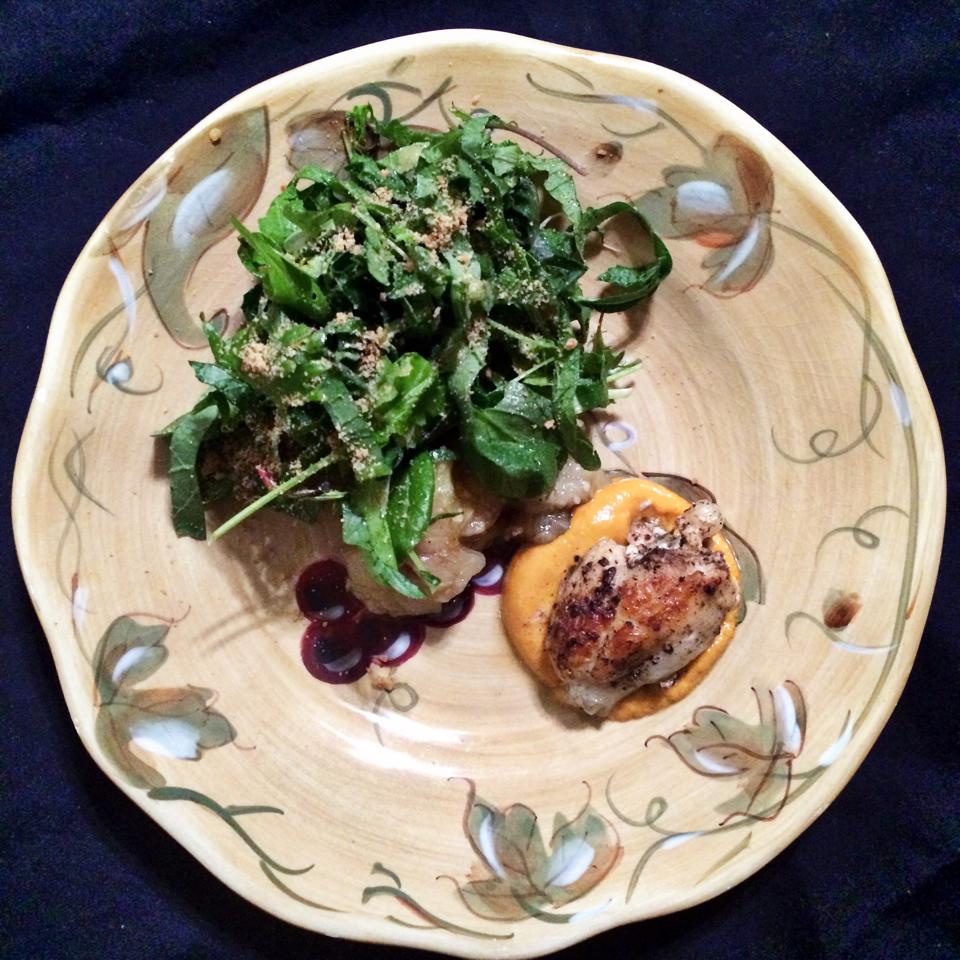
During prep at FRANK we play a game called “Either/Or.” Bob Dylan or Neil Young? Beer or Wine? Seattle or Portland? Potato and Leek or Potato and Chive? That last one got us all arguing about whether the flavors of leek or chive are a better match for potato. So when conceiving our soup, there was considerable consternation about whether it should be potato leek, or potato chive. Eventually we all compromised and did both! All members of the allium family (garlic, onions, leeks, etc.) contain a compound called allicin, which in moderate doses is incredibly good for us. It lowers our blood pressure and cholesterol. It has anti-cancer properties. But in extremely high doses, allicin can actually cause genetic mutation, which is of concern for cancer and reproduction. This discovery was made in 2003 and published by the National Institute of Health. So the moral of the story is…eat lots of garlic, but don’t eat pounds of it raw every day!
Our soup was a major hit…a base stock made from smoked pork hocks, with golden potatoes, tons of caramelized leeks, chives, a liberal dose of white pepper, and enriched with housemade buttermilk. We finished it with dry-cured country ham, crispy fried leeks, and a poisonous puree of tomato leaves! Remember that tomatoes are a nightshade so the green parts of the plant contain the toxin solanine. However, as we know, solanine breaks down when cooked, so if you blanch tomato leaves, you make them safe to eat! It’s sad to me that more chefs don’t cook with tomato leaves, they have SUCH a pungent, bright, astringent flavor that’s totally tomato in one moment, and totally something else in the next. If you grow tomatoes at home, try picking a handful of leaves and adding them to your tomato sauce as it simmers. (It will BLOW your mind!)

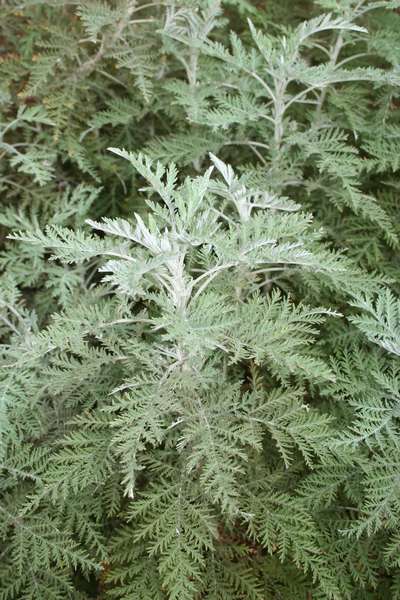
For the sorbet course, we all knew immediately what we’d have to do. Absinthe! For those who aren’t familiar with absinthe, it’s a very old type of liqueur that, in its traditional form, contains an extraction of the plant wormwood, or artemesia absinthum…from which the liquor takes its name. Wormwood was used for millenia by primitive cultures to cleanse their bodies of parasites, because the plant contains a toxin called thujone. Overdosing on thujone causes potent hallucinations, so the plant was deliberately used as a drug starting in ancient Greece, and became very popular in France and Switzerland in the 1800s. Much loved by creative folks, absinthe was known as “the poet’s third eye” and was celebrated by such artistic powerhouses as Rimbaud, Degas, Hemingway, Wilde, and Van Gogh. The tricky part about drinking an alcohol that contains an additional poison, though, is in controlling the dosage…and excessive alcohol consumption can remove that internal self-protection instinct we have, so absinthe (and thus thujone) overdoses were very common. In higher doses, thujone causes temporary insanity. Van Gogh cut off his own ear during an absinthe-induced fit of madness. And in high enough doses, thujone causes death. This is why absinthe was banned by virtually every developed nation in the world in the early 1900s, and remains banned, in its traditional form, even today. Yes, I know you can go to the liquor store and buy a bottle of something labeled “absinthe.” But it’s not real. By law, absinthe in the US cannot contain any traceable amount of thujone…meaning it cannot be made with wormwood, or artemisia absinthum, which is the very plant that gives the liquor its name. So buy and drink all the absinthe you want…you’ll never see the mythical green fairy, or feel the need to cut off your ear. Luckily, someone in the FRANK team has been making real absinthe at home for a decade, so our diners were actually able to taste true, authentic absinthe, for what may be the only time in their lives! Not enough to cause fits of madness, of course. Real absinthe is actually VERY hard to drink. Thujone is intensely bitter…and that adjective was the most common way our diners described the taste. “INTENSE!” Those who have palates that are very sensitive to bitterness typically only ate a bite or two. But the majority devoured every last bit of the sorbet, relishing the assault on their palates.
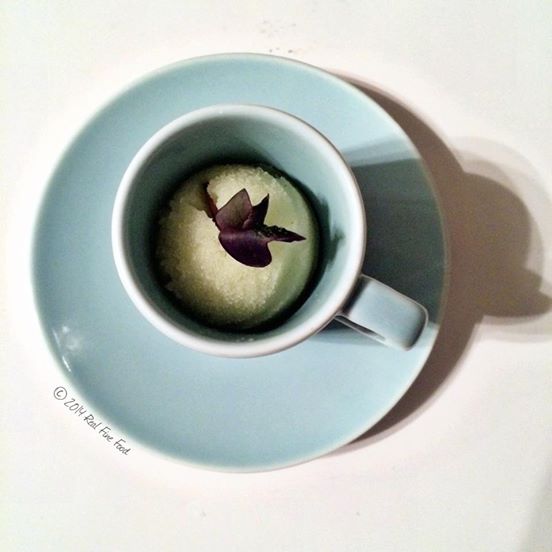
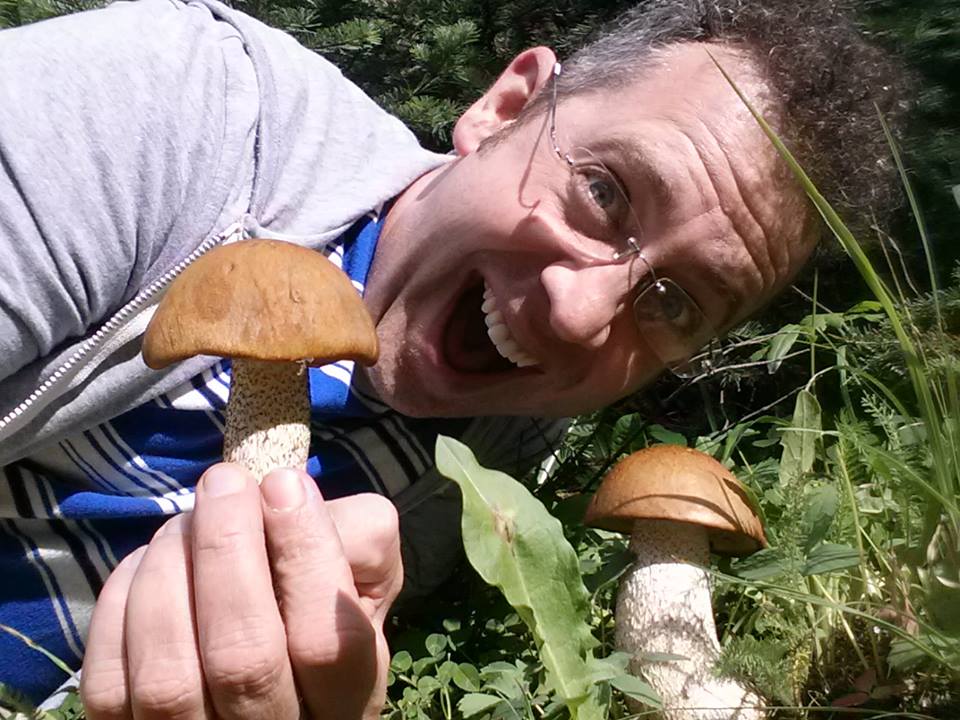
When most people think of toxic foods, they immediately think of wild mushrooms. Growing up, your mom always screamed at you when you bent down to look at a toadstool. Americans are the most fungaphobic culture on the planet. We are absolutely TERRIFIED of any mushroom that’s not in the grocery store. Which is both good and bad. Truthfully, there are only a small handful of wild mushrooms that are lethal. But eat the wrong one, and unless you get a liver transplant within 6 hours, no medicine in the world can keep you alive. So wild mushrooms should always be treated with respect. But if you accurately identify an edible wild mushroom, there’s ZERO danger in eating it. I’ve been rabidly foraging and devouring wild mushrooms for many years, and have never been made sick, because I will NOT eat a mushroom that I can’t absolutely, positively identify. If there’s any question at all, it goes in the trash. Identification comes through education, and I had a fan on my Facebook page chastise me this weekend for posting photos of myself foraging wild mushrooms, saying her friend’s daughter died of wild mushroom poisoning and I shouldn’t be promoting it. I couldn’t disagree more…education is what will PREVENT mushroom poisonings. When we stay in the dark about it, we don’t have the knowledge to know what is safe and what isn’t. So if you’re interested in wild mushrooms, join a local mycology club, or get yourself a box full of mushroom field guides, and get out there after it rains. You’ll be amazed at what you find!
We decided to feature wild mushrooms in a risotto…a classic pairing. Our risotto stock was made from dried porcini mushrooms. No one has figured out how to cultivate porcinis, which are known as King Boletes here in the US, so every porcini eaten on the planet was found in the wild by a mushroom hunter. I think that’s magical. Porcinis are dark and intense mushrooms, especially when they are dried, and our mushroom stock tasted richer and more dense than any meat stock ever could. Then we folded in 2 varieties of wild mushroom: hen of the woods and beech. Hen of the woods, known as maitake in Japan, grow all over the US in the fall at the base of oak trees after the first cool rains. They can grow to massive size, as you can see by the grin of this lucky forager who found 2 giant hens:
Many devotees of this mushroom believe it is the most delicious of all the wild mushrooms, and I have a hard time disagreeing. On top of our risotto we plated a gravy made from the reduced braising liquid from our beef, thickened with pureed mushroom stems. Insanely beefy, intensely mushroomy… I’d like an IV of it, please! And atop the gravy was a chunk of short rib…one of our favorite proteins at FRANK…from the Beeman Family Ranch here in Texas. The Beeman family have several ranches around the state and are the only American cattle ranchers that are certified by the government of Japan to raise pure-bred Akaushi beef. “Akaushi” is one of 4 breeds of cattle that can be called “Wagyu” which is a term you often see at nice restaurants. “Akaushi” just means “red cow” in Japanese, and most US ranchers have cross bred the Akaushi with our more popular cattle, like Angus, to produce what’s known as “American Wagyu.” But not the Beeman family…they have kept tight genetic restraints on their herds to ensure they are purebred Akaushi, and this beef is just extraordinary:

This is USDA Prime beef. Lots of folks don’t understand the USDA rating, but it’s all about fat. Intramuscular fat, and how evenly and liberally it’s distributed within the meat. The more fat and the more evenly distributed it is, the higher the grade. So why do we want MORE fat in our beef? It’s all about texture and flavor. Lean beef is tougher, dryer, and tastes more gamey than fatty beef, and therefore less desirable if you’re seeking out beef as a premium product. (Of course, there are MANY reasons to seek out lean, grass-fed beef…but it’s an entirely different thing, more suitable for everyday eating.) Beef like this cooks up fork tender, melts in your mouth, and is breathtakingly, offensively expensive. But totally worth it. Appropriate for a splurge. We had multiple diners say it was the best beef they had ever tasted. Two well-dined guests on separate nights compared it to Morimoto’s A-5 Wagyu beef, which, at $200 for a 4 ounce steak, means FRANK is a steal! *giggle*
We rubbed the beef with the two most popular toxic ingredients in America: chocolate and coffee. And yes…they are both poisonous. Chocolate contains a toxic alkaloid called theobromine, which is poisonous to humans in large quantities, just as it’s poisonous to dogs and cats. You’d have to eat about 80 pounds of dark chocolate to ingest enough theobromine to actually kill yourself (if you weigh around 180 pounds), but theobromine poisoning is a very real concern, particularly for the elderly. Death by Chocolate is a real thing! Coffee contains another toxic alkaloid that many of us are actually addicted to…called caffeine. In small doses, doctors tell us that caffeine is good for us, stimulating our metabolism, keeping us active, and improving our cardiovascular system. But in higher doses, it will kill you dead. Swallow a bottle of caffeine pills and if you don’t get your stomach pumped, you’ll be spending the night in the morgue. Of course, you’d have to drink 80-100 shots of espresso over a few hours to kill yourself with coffee, and I’m not sure ANYONE can handle that much! But coffee and chocolate go absolutely swimmingly with beef, and after searing our short rib to a dark crust, we braised it in red wine with coffee, cocoa, and veggies for 4 hours at low temp until it was fork tender, but still cohesive enough to not fall apart when taking it out of the pot. Then we crisped it under the broiler with more of our coffee/cocoa rub before serving it. Perched atop the beef were tiny, delicate enoki mushrooms and wild mustard flowers, and around the plate were pungent garlic blossoms…one of my favorite wild ingredients.

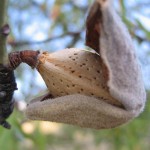
Alas, we come to dessert, and we decided to revisit the chocolate/coffee pairing by making pots-de-creme, French for “cream pot.” Sort of an intermediate step between pudding and custard, these rich little suckers were made with two types of dark chocolate, Valrhona from France, and El Rey from Venezuela. As an added punch, we incorporated another toxic ingredient…spicy chiles! I love spicy chocolate, it’s such a perfect pairing… you get dark, rich, sweet, and bitter at the outset, and it finishes with a slight heat in the back of your throat. We topped the cream pots with some coarse sea salt to help contrast the sweetness of the dish. And sticking out of the top of the pot was a tuile (ie, crisp cookie) of almond and nutmeg…both very poisonous ingredients. Almonds supply the majority of the world with pharmaceutical grade cyanide. Part of the stone-fruit family like peaches and apricots, the almond kernel is lethally toxic in cyanide when raw, so even when you buy “raw” almonds in the grocery store, they have first been thoroughly steamed to break down all that cyanide! (If you crack open a peach or apricot pit, you’ll find an almond-like seed inside, which is poisonous. But simmer it in white wine for half an hour and it will infuse an almond-like flavor into the wine, as well as make it safe to eat. I did this on MasterChef, and Ramsay was a bit dubious!)
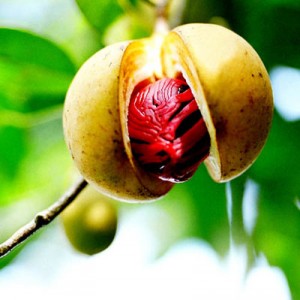
Nutmeg is the seed of an evergreen fruit tree from the tropics. Upon maturity, the fruit splits open, revealing the nutmeg seed wrapped in a lacy red membrane which is ground the make the spice mace. (NOT related to mace spray.) Nutmeg contains a toxin called myristicin that, in fairly small doses, causes hallucination. It is still a traditional and popular cultural hallucinogen in Indonesia and India, and for awhile in the 70s, it was explored by the counter culture crowd here in the US. (It’s side effects are nausea, headaches and body pain, though, so it’s not a “fun” drug.) In slightly higher doses, it can cause miscarriage, so use nutmeg sparingly if you are pregnant. In high enough doses, it can kill. Luckily, nutmeg is VERY pungent, and a little goes a very long way!
And we wanted to finish the dessert with something a little daring, as well as poisonous, so we made some chocolate covered harvester ants to garnish the plate! Ants are a major source of protein in much of the developing world. They are delicious and nutritious, as well as plentiful. In America we don’t really have a culture of eating bugs, but many other cultures certainly do…even our neighbors in Mexico have an affinity for grasshoppers! I’ve eaten many insects…here I am crunching termites in Belize:
 (For the record, termites are indistinguishable from carrots…they taste exactly alike.)
(For the record, termites are indistinguishable from carrots…they taste exactly alike.)
I’ve eaten all sorts of insects in my travels, and ants are among the most accessible. They are crunchy, earthy/woody, and a little bit spicy. There’s no weird texture to get around…they’re just delicious if you can get past the mental block. Ants contain formic acid, the poison that burns when an ant stings you. In the mouth, though, that just translates to a bit of a peppery flavor. We ordered our ants from Life Studies Farm in Utah, who normally sell them to supply children’s ant farms, or for people who keep lizards as pets and need to feed them. They were a bit puzzled when I asked for a thousand ants to use at my restaurant, but they sent them anyway! They arrived through the mail a day later, bustling and angry!
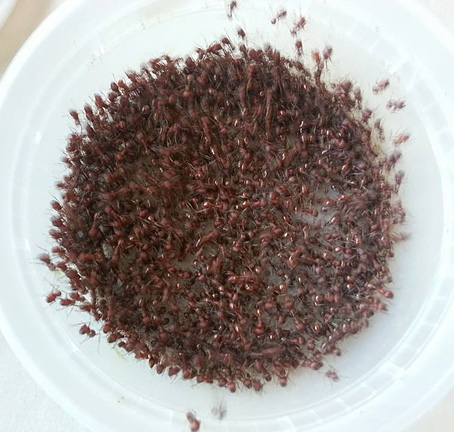
To humanely dispatch the ants, they went into the freezer for an hour, then into the microwave for a minute. (One of the only things we use the microwave for at FRANK, other than warming plates.) After this, they were ready to be coated in dark chocolate!

The only legitimate recipes you’ll find on the internet for chocolate covered ants are for chocolate candies with ants on the inside, sort of like nuts. This is because it’s exhausting to make individual chocolate covered ants! But we love our diners at FRANK, so we did it for them!
The dessert was a huge hit…some of our regulars said it was the yummiest dessert they’ve had at FRANK. Some were leery of eating the ants. Some asked for extra ants. One regular said he’d eat them by the handful if they were commercially produced!

Overall, this was probably the most fun menu we’ve put out in the 2 and a half year history of FRANK. Our diners got a real kick out of eating all the poisonous foods, learning that some of their favorite foods were poisonous, and daring each other to eat frogs and ants. Many of our regulars said that, poison and bugs aside, it was the most delicious and cohesive menu they’ve had at FRANK before, which was a true honor to hear. I spent more time at the table, discussing and educating, than I’ve EVER spent at a FRANK before. It was great fun, thanks to all our brave diners!
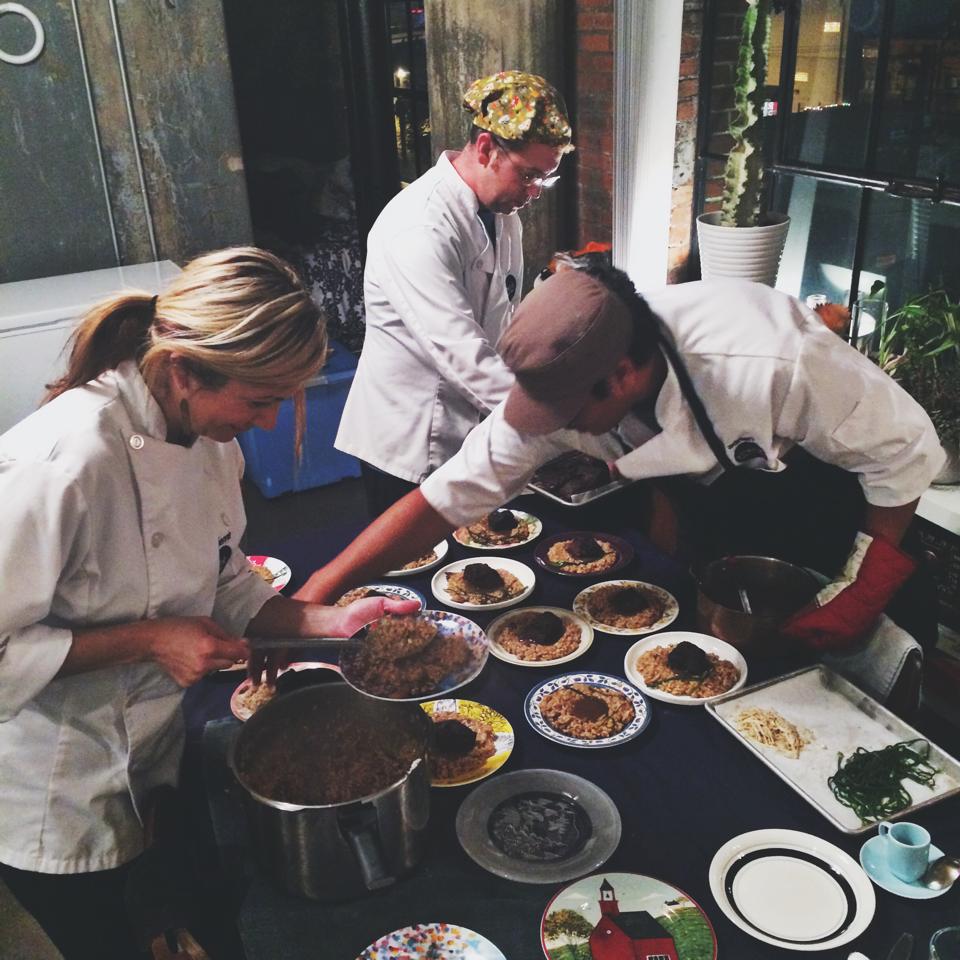
Follow Stephanie Casey with Real Fine Food on Instagram and Facebook! And thanks, Stephanie, for helping our fans experience the dinner in real time on our social media!
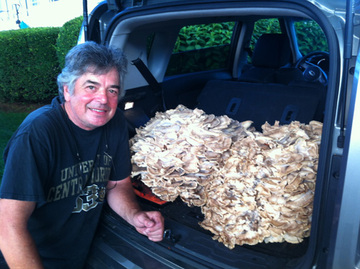


Leave a Reply
You must be logged in to post a comment.